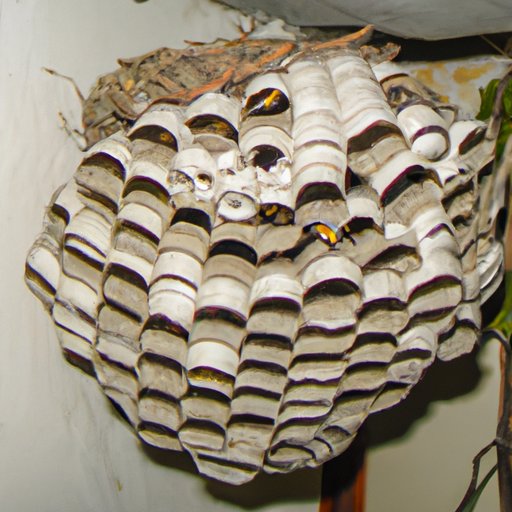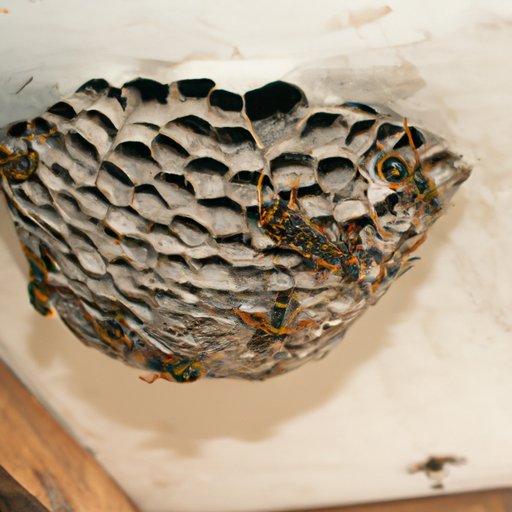
I. Introduction
If you have a wasp nest on your property, you know how unsettling it can be. Wasps can be dangerous, and disturbing their nest can lead to painful stings. But getting rid of a wasp nest can be tricky, especially if you’re not sure what you’re doing. That’s where this guide comes in. In this article, we’ll explore natural remedies, DIY methods, and professional extermination options for getting rid of a wasp nest, as well as preventative measures for keeping wasps from nesting in the first place. We’ll also discuss how to identify a wasp nest and determine the best method of removal.
II. Natural remedies to get rid of wasp nests
There are several natural remedies for getting rid of a wasp nest. These include:
- Boiling water
- Vinegar
- Lemon juice
- Peppermint oil
- Clove oil
Each of these remedies works by either suffocating or repelling the wasps. For example, boiling water can be poured over the nest to kill the wasps, while peppermint oil can be used to repel them. However, it’s important to note that natural remedies may not be as effective as other methods, and may not work for all types of wasps.
One major benefit of natural remedies is that they are generally safe and eco-friendly. You don’t have to worry about harmful chemicals or toxins, and you can feel good about using a more natural approach to pest control. However, natural remedies may require more time and effort than other methods, and may not be as effective for large or established nests.
III. DIY methods for eliminating wasp nests
If you’re looking for a more hands-on approach, there are several DIY methods for eliminating a wasp nest. These include:
- Using a wasp trap
- Smoking the nest
- Knocking down the nest
- Using soapy water
Each of these methods has its own advantages and disadvantages. For example, using a wasp trap is a passive method that can be effective for catching individual wasps. Smoking the nest can be an effective way to calm the wasps before attempting to remove the nest, while knocking down the nest is a more aggressive approach that should only be used if you’re confident in your ability to do so safely. Using soapy water can suffocate the wasps, but may not be effective for larger nests.
DIY methods are generally more affordable than professional extermination, and can be effective for smaller nests. However, DIY methods can be dangerous if not done properly, and may not be effective for larger or more established nests. It’s important to carefully consider your options and assess the risks before attempting to remove a wasp nest on your own.
IV. Professional extermination of wasp nests
Professional extermination is often the safest and most effective way to eliminate a wasp nest. There are several methods that professional exterminators may use, including:
- Chemical sprays
- Insecticide dust
- Vacuuming
Each of these methods has its own advantages and disadvantages. Chemical sprays can be effective for killing the wasps and destroying the nest, but may require multiple treatments for larger nests. Insecticide dust can be effective for killing the wasps inside the nest, but may not be as effective for destroying the nest itself. Vacuuming can be effective for removing the nest, but may require specialized equipment.
Professional extermination can be expensive, but it’s worth it if you have a large or established nest that may be dangerous to remove on your own. Professional exterminators also have the knowledge and expertise to ensure that the nest is safely and thoroughly removed.
V. Preventative measures to keep wasps from nesting
The best way to deal with a wasp nest is to prevent it from forming in the first place. There are several preventative measures you can take to keep wasps from nesting on your property, including:
- Sealing cracks and gaps in your home
- Removing potential nesting sites, such as old furniture or appliances
- Keeping your garbage cans tightly sealed
- Removing standing water
- Avoiding bright colors and floral prints when spending time outside
Preventative measures are generally safe and easy to implement, and can save you the time and hassle of dealing with a wasp nest later on. However, some preventative measures may require more effort or expense, such as sealing cracks in your home or installing screens on windows and doors.
VI. Dealing with multiple wasp nests on your property
If you have multiple wasp nests on your property, it’s important to deal with them in a strategic and safe manner. Start by identifying each nest and assessing its size and location. Then, prioritize the nests based on their proximity to high-traffic areas or potential hazards, such as a playground or swimming pool. Finally, choose the method of removal that is safest and most effective for each individual nest.
Dealing with multiple nests can be time-consuming and potentially dangerous, especially if you’re not familiar with the wasps or their behavior. Consider seeking professional help if you have several nests on your property or feel overwhelmed by the task at hand.
VII. The dangers of leaving a wasp nest untreated
Leaving a wasp nest untreated can be dangerous for you and your family. Wasps can become aggressive if they feel threatened, and may attack if they sense danger to their nest. Additionally, large or established nests can pose a risk to your home’s structure, and may also attract other pests, such as mice or rats. In general, it’s best to address a wasp nest as soon as you notice it, rather than waiting and risking potential harm.
However, it’s important to note that removing a wasp nest can be dangerous as well. Always take proper precautions when attempting to remove a nest, such as wearing protective clothing and working during cooler hours when wasps are less active.

VIII. How to identify a wasp nest and determine the best method of removal
Identifying a wasp nest is the first step in determining the best method of removal. Common signs of a wasp nest include:
- A steady stream of wasps entering and exiting a single location
- A cone-shaped paper nest, usually suspended from a high location
- A ground nest, often marked by a hole in the dirt
Once you’ve identified the nest, consider its size and location, as well as the type of wasp that is present. This information will help you determine the best method of removal, whether it’s a natural remedy, DIY method, or professional extermination. It’s important to choose a method that is safe, effective, and appropriate for the specific nest you’re dealing with.
IX. Conclusion
Getting rid of a wasp nest can be a daunting task, but with the right knowledge and tools, it can be done safely and effectively. Whether you choose a natural remedy, DIY method, or professional extermination, it’s important to assess the risks and choose the method that is best for your situation. Additionally, taking preventative measures to keep wasps from nesting can save you the time and hassle of dealing with a nest in the future. Remember to always take proper precautions when dealing with a wasp nest, and seek professional help if you’re unsure or overwhelmed.





